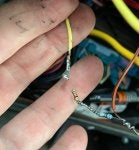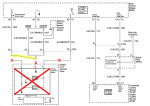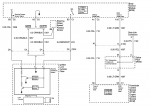I have a 2000 Silverado 1500 with an aftermarket remote start that was installed years ago and before I purchased the truck.
In the two years I've owned the vehicle, I've had about four occasions where the truck refused to start presumably because of Passlock. There is a "security" message on the dash and after waiting a few minutes, it starts right up. It does not matter if I leave the key in or out of the ignition. As long as I wait and retry in 5-10 minutes, it starts as if nothing was wrong.
I've pulled the codes from the computer any time I've checked, I always get these three...
P1631 - Anti-theft Device - PCM/IPC Password Error
B2960 - Security system sensor data incorrect but valid
B2961 - Key in ignition circuit malfunction
I clear the codes with the scanner after each occurrence of the no-start condition.
The last two instances happened only a few weeks apart making me afraid that this problem is becoming more frequent. During one failure to start, it happened while trying to use the remote starter. This leads me to believe the failure has nothing to do with the key, lock cylinder, or ignition switch.
What I observed on the last occurrence. I left the key in the ON position and watched the light flash red with battery symbol and alternate to flashing yellow security message. This happened for many minutes until it just stayed on solid yellow with the security message. I was stranded for close to 40 minutes trying to wait it out with the key in the ON position for various lengths of time in 5-10 minute chunks. I don't think I was doing the re-learn correctly. It wasn't until I put in the OFF position for 5-10 minutes that I was finally able to start it. During that last period of time, I was trying to start it repeatedly. It eventually started.
Another related problem is that the yellow security message has come on either while driving or immediately after starting the car. This has happened only a few times over the last two years, but it's happening a lot more frequently now. Perhaps a couple times per week over the last few weeks. This does not interfere with driving nor does it prevent the car from starting. I can throw it into neutral, turn off the engine, and restart it to clear the yellow message.
I've been Googling this, and nearly everything comes to "do a re-learn" or "install a bypass". Since I have a remote start, I should already have a bypass, and the problem happened once while triggering the remote start. As far as I know, I cannot do a re-learn when the car starts right up. And since the problem is intermittent, I guess doing a re-learn is pointless? I also hesitate to purchase a new ignition switch since the problem also occurred during a remote start.
Given the three simultaneous codes, and the problem descriptions/symptoms, I am very interested in anyone's thoughts about where/how I should start troubleshooting. Thank you!
In the two years I've owned the vehicle, I've had about four occasions where the truck refused to start presumably because of Passlock. There is a "security" message on the dash and after waiting a few minutes, it starts right up. It does not matter if I leave the key in or out of the ignition. As long as I wait and retry in 5-10 minutes, it starts as if nothing was wrong.
I've pulled the codes from the computer any time I've checked, I always get these three...
P1631 - Anti-theft Device - PCM/IPC Password Error
B2960 - Security system sensor data incorrect but valid
B2961 - Key in ignition circuit malfunction
I clear the codes with the scanner after each occurrence of the no-start condition.
The last two instances happened only a few weeks apart making me afraid that this problem is becoming more frequent. During one failure to start, it happened while trying to use the remote starter. This leads me to believe the failure has nothing to do with the key, lock cylinder, or ignition switch.
What I observed on the last occurrence. I left the key in the ON position and watched the light flash red with battery symbol and alternate to flashing yellow security message. This happened for many minutes until it just stayed on solid yellow with the security message. I was stranded for close to 40 minutes trying to wait it out with the key in the ON position for various lengths of time in 5-10 minute chunks. I don't think I was doing the re-learn correctly. It wasn't until I put in the OFF position for 5-10 minutes that I was finally able to start it. During that last period of time, I was trying to start it repeatedly. It eventually started.
Another related problem is that the yellow security message has come on either while driving or immediately after starting the car. This has happened only a few times over the last two years, but it's happening a lot more frequently now. Perhaps a couple times per week over the last few weeks. This does not interfere with driving nor does it prevent the car from starting. I can throw it into neutral, turn off the engine, and restart it to clear the yellow message.
I've been Googling this, and nearly everything comes to "do a re-learn" or "install a bypass". Since I have a remote start, I should already have a bypass, and the problem happened once while triggering the remote start. As far as I know, I cannot do a re-learn when the car starts right up. And since the problem is intermittent, I guess doing a re-learn is pointless? I also hesitate to purchase a new ignition switch since the problem also occurred during a remote start.
Given the three simultaneous codes, and the problem descriptions/symptoms, I am very interested in anyone's thoughts about where/how I should start troubleshooting. Thank you!











